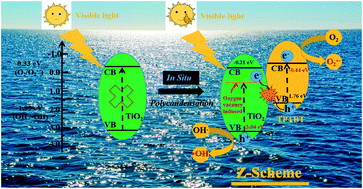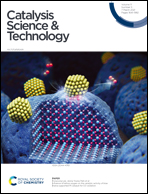Oxygen vacancy-induced donor–acceptor-conjugated microporous poly(triphenylamine–benzothiadiazole)/TiO2 as a Z-scheme heterojunction photocatalyst towards a visible-light-driven degradation of bisphenol A†
Abstract
Herein, a kind of donor–acceptor-conjugated microporous polymer (D–A CMP), poly(triphenylamine–benzothiadiazole) denoted as TPABT, was introduced to synthesize a novel organic–inorganic heterojunction photocatalyst with TiO2 by in situ polycondensation. Resultant TPABT/TiO2 composites were used to photodegrade bisphenol A (BPA) under visible light. Results indicated that the TPABT/TiO2 composite with a mass ratio of TPABT to TiO2 of 10 : 100 (labeled as 10-TPABT/TiO2) showed optimum photocatalytic activity, 8 and 4 times that of pure TiO2 and TPABT, respectively. Systematic characterizations revealed that the incorporation of TPABT caused the generation of oxygen vacancies on TiO2, which improved the visible light responsiveness of TiO2. Moreover, EIS (electrochemical impedance spectroscopy), photocurrent response and PL emission spectra suggested that 10-TPABT/TiO2 composites exhibited optimum activity than TPABT and TiO2. Moreover, detailed investigations indicated that the improvement in the photoactivity of TPABT/TiO2 contributed to the formation of a Z-scheme heterojunction, which enhanced the charge transfer from TPABT to TiO2. This work provides some interesting ideas for enhancing the photocatalytic activity of TiO2 and exploiting efficient heterojunction photocatalysts based on CMPs for pollutant degradation.



 Please wait while we load your content...
Please wait while we load your content...